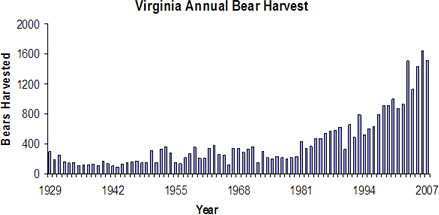
 |
Rockingham - Harrisonburg Chapter |
By Jaime Sajecki, Black Bear Project Leader
Bear management in Virginia is constantly changing to meet the needs of residents, sportsmen, and other wildlife recreationists in the Commonwealth. Hunters provide the Department with some of the most important data used to manage the growing population of bears in Virginia. Accurate data collected from hunters at check stations on the location of harvest, sex of the bear harvested, and the age of the bear harvested from the submitted premolar are invaluable management tools. Department biologists use the hunter-submitted information and biological samples to determine the sex ratio, age structure, and relative population densities of black bears throughout the state. Recommendations on bear management including the timing, location, and duration of hunting seasons are assessed and modified due, in part, to the biological information extrapolated from the bear harvest. The Virginia Black Bear Management Plan (at the VDGIF web site: http://www.dgif.virginia.gov/wildlife/bear/) serves as an outline and guide for bear management through 2010. The Virginia Department of Game and inland Fisheries has produced a video “Living with Black Bears” which addresses the history of bears in Virginia, management, and tips on coexisting with bears. This video can be viewed by going to http://www.dgif.virginia.gov/video/ .
In Virginia, 1523 bears were harvested during the 2007-08 season. Virginia’s black bear harvest trend has been increasing at an average annual rate of 7.4% per year over the past decade. The 2007-08 harvest was 7.5% less than last year’s harvest of 1633 bears but was very similar to the 2003-04 harvest of 1,511 bears and the second highest bear harvest documented in Virginia.
Bear harvests west and east of the Blue Ridge Mountains were 1,040 (68% of the harvest) and 483 (32 % of the harvest), respectively. Comparatively, in 2006, 75% of the harvest was west of the Blue Ridge Mountains. Similar to the last few years, the eight counties surrounding Shenandoah National Park produced 38% (575 bears) of the total bear kill.
The archery harvest of 393 bears (25% of the total harvest) was comparable to the 2006-07 season. Also similar to the 2006-07 season, crossbows accounted for 38% of the entire archery harvest of bears. Over 70% of the archery harvest was west of the Blue Ridge Mountains.
The 4-day muzzleloading season accounted for 92 bears (6.1% of the total harvest). This was similar to the 6% of bears harvested during the 2006-07 muzzleloading season.
The 2007-08 regular firearms harvest of 1038 bears was slightly decreased from the harvest of 1118 bears in the 2006-07 season. Dog hunters accounted for 52% of the regular firearms harvest and 35% of the total bear kill.
Similar to the long-term average of 37%, the harvest was comprised of 35% females. Bear hunters in all seasons and hunter groups harvested a similar proportion of females. The percent female composition of the archery, muzzleloader, and regular firearms season was 37%, 34%, and 34%, respectively. Female bears represented 31% of the hound-hunter harvest.
| 2007-08 | Harvest | 2006-07 | Harvest |
|---|---|---|---|
| Rockingham | 159 | Rockingham | 162 |
| Page | 82 | Augusta | 124 |
| Rockbridge | 80 | Alleghany | 113 |
| Albemarle | 78 | Shenandoah | 91 |
| Augusta | 77 | Page | 90 |
| Madison | 76 | Madison | 89 |
| Shenandoah | 72 | Bath | 75 |
| Botetourt | 66 | Rockbridge | 69 |
| Highland | 65 | Craig | 66 |
| Nelson | 59 | Albemarle | 63 |

|
Copyright © 2005-
R-H Chapter IWLA & Mountain View Product Marketing, Inc. Created by Mountain View Product Marketing, Inc. Hosted by ShenValleyOnline.net. |
